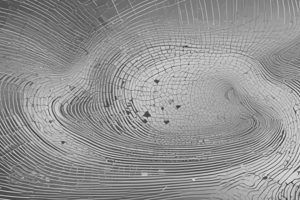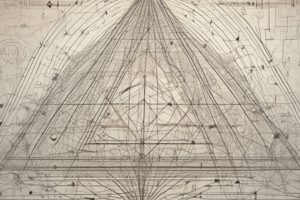Podcast
Questions and Answers
What characterizes a vector as opposed to a scalar?
What characterizes a vector as opposed to a scalar?
- A scalar includes direction.
- A vector has magnitude and direction. (correct)
- A scalar can only be a positive number.
- A vector has only a magnitude.
What effect does multiplying a vector by a negative scalar have?
What effect does multiplying a vector by a negative scalar have?
- It has no effect on the vector.
- It increases the magnitude of the vector.
- It decreases the magnitude of the vector.
- It changes the direction of the vector. (correct)
How do you find the resultant of two collinear vectors?
How do you find the resultant of two collinear vectors?
- By applying the sine rule.
- By multiplying the vectors.
- By using the Pythagorean theorem.
- By performing algebraic or scalar addition. (correct)
According to the parallelogram law, how does the resultant of two forces relate to the parallelogram formed by these forces?
According to the parallelogram law, how does the resultant of two forces relate to the parallelogram formed by these forces?
Which method is used to find components of a force along two axes?
Which method is used to find components of a force along two axes?
When using the law of cosines to find the resultant of two forces, which of the following is not included in the formula?
When using the law of cosines to find the resultant of two forces, which of the following is not included in the formula?
What does the law of sines allow you to calculate when dealing with forces?
What does the law of sines allow you to calculate when dealing with forces?
What must be true for the resultant of two forces to be expressed using the parallelogram law?
What must be true for the resultant of two forces to be expressed using the parallelogram law?
What is the formula to determine the magnitude of a force F given its Cartesian components?
What is the formula to determine the magnitude of a force F given its Cartesian components?
How are the coordinate direction angles a, b, and g related in terms of the unit vector u?
How are the coordinate direction angles a, b, and g related in terms of the unit vector u?
In the expression for a force F, which component represents the direction along the y-axis?
In the expression for a force F, which component represents the direction along the y-axis?
To calculate the resultant force FR from a concurrent force system, what must be done?
To calculate the resultant force FR from a concurrent force system, what must be done?
Which of the following represents the unit vector in the direction of a force F?
Which of the following represents the unit vector in the direction of a force F?
Which statement about the angles a, b, and g is true?
Which statement about the angles a, b, and g is true?
What does the notation $F = Fx i + Fy j + Fz k$ represent?
What does the notation $F = Fx i + Fy j + Fz k$ represent?
In the equation $u = cos a i + cos b j + cos g k$, what do the variables cos a, cos b, and cos g represent?
In the equation $u = cos a i + cos b j + cos g k$, what do the variables cos a, cos b, and cos g represent?
What does the resultant force FR depend on?
What does the resultant force FR depend on?
How is the angle u defined in relation to the vector F?
How is the angle u defined in relation to the vector F?
What does the unit vector u represent?
What does the unit vector u represent?
Which equation correctly represents how to calculate the x-component of the resultant force?
Which equation correctly represents how to calculate the x-component of the resultant force?
Which expression represents the correct calculation for the resultant force in two dimensions?
Which expression represents the correct calculation for the resultant force in two dimensions?
What occurs when the components of a force are not acting at right angles?
What occurs when the components of a force are not acting at right angles?
If a force vector F has components Fx and Fy, which of the following is TRUE?
If a force vector F has components Fx and Fy, which of the following is TRUE?
Which of the following is NOT a characteristic of the rectangular components of a force?
Which of the following is NOT a characteristic of the rectangular components of a force?
What does a position vector represent in space?
What does a position vector represent in space?
How can a force vector be expressed if it acts in the same direction as the position vector?
How can a force vector be expressed if it acts in the same direction as the position vector?
What is the result of the dot product of two vectors?
What is the result of the dot product of two vectors?
In Cartesian vector form, how is the dot product calculated?
In Cartesian vector form, how is the dot product calculated?
Which mathematical operation is used to calculate the angle between two vectors?
Which mathematical operation is used to calculate the angle between two vectors?
What does the unit vector 'u' signify in relation to a force vector?
What does the unit vector 'u' signify in relation to a force vector?
What is represented by the components of a position vector?
What is represented by the components of a position vector?
Which of the following statements regarding vectors is incorrect?
Which of the following statements regarding vectors is incorrect?
Flashcards
Scalar
Scalar
A quantity that has magnitude only, but no direction.
Vector
Vector
A quantity that has both magnitude and direction.
Collinear Vectors
Collinear Vectors
Vectors that lie on the same line.
Parallelogram Law
Parallelogram Law
Signup and view all the flashcards
Components of a Force
Components of a Force
Signup and view all the flashcards
Rectangular Components
Rectangular Components
Signup and view all the flashcards
Resultant Force
Resultant Force
Signup and view all the flashcards
Unit Vector
Unit Vector
Signup and view all the flashcards
Cartesian Components
Cartesian Components
Signup and view all the flashcards
Position Vector
Position Vector
Signup and view all the flashcards
Force Vector
Force Vector
Signup and view all the flashcards
Dot Product
Dot Product
Signup and view all the flashcards
Concurrent Forces
Concurrent Forces
Signup and view all the flashcards
Cartesian Vector
Cartesian Vector
Signup and view all the flashcards
Magnitude of vector
Magnitude of vector
Signup and view all the flashcards
Coordinate direction angles
Coordinate direction angles
Signup and view all the flashcards
Algebraic Vector Addition
Algebraic Vector Addition
Signup and view all the flashcards
Study Notes
Scalars and Vectors
- Scalars have magnitude only and are represented by positive or negative numbers. Examples include mass and temperature.
- Vectors have both magnitude and direction. The arrowhead indicates the direction of the vector.
- Multiplying or dividing a vector by a scalar changes its magnitude.
- If the scalar is negative, the direction of the vector reverses.
Vector Addition
- Collinear Vectors: When vectors are collinear, their resultant is found by simple algebraic or scalar addition.
- Parallelogram Law: Two forces are added according to the parallelogram law. The components of the forces form the sides of the parallelogram, and the resultant is the diagonal.
- Components of a Force: To find the components of a force along any two axes, draw lines from the head of the force parallel to the axes.
Rectangular Components
- Two Dimensions: Vectors Fx and Fy are the rectangular components of F.
- Resultant Force: The resultant force is determined from the algebraic sum of its components.
- Angle: The angle of the resultant force is determined by the arctangent of the component forces.
Cartesian Vectors
- Unit Vector: A unit vector u has a length of 1, no units, and points in the direction of the vector F.
- Cartesian Components: A force can be resolved into Cartesian components along the x, y, z axes. (F = Fx i + Fy j + Fz k)
- Magnitude: The magnitude of F is calculated using the Pythagorean theorem.
- Coordinate Direction Angles: The coordinate direction angles (a, b, g) are determined by formulating a unit vector in the direction of F.
Resultant of Concurrent Forces
- Sum of Components: To find the resultant of concurrent forces expressed as Cartesian vectors, add the i, j, k components of all forces.
Position and Force Vectors
- Position Vector: A position vector locates one point in space relative to another. Determine the distance and direction from the tail to the head of the vector along the x, y, and z axes to find the components of the position vector.
- Force Vector: If the line of action of a force passes through points A and B, the force vector is in the same direction as the position vector, which is defined by the unit vector u. The force can be expressed as a Cartesian vector.
Dot Product
- Scalar: The dot product of two vectors results in a scalar.
- Cartesian Form: If A and B are Cartesian vectors, the dot product is the sum of the products of corresponding components.
Studying That Suits You
Use AI to generate personalized quizzes and flashcards to suit your learning preferences.




